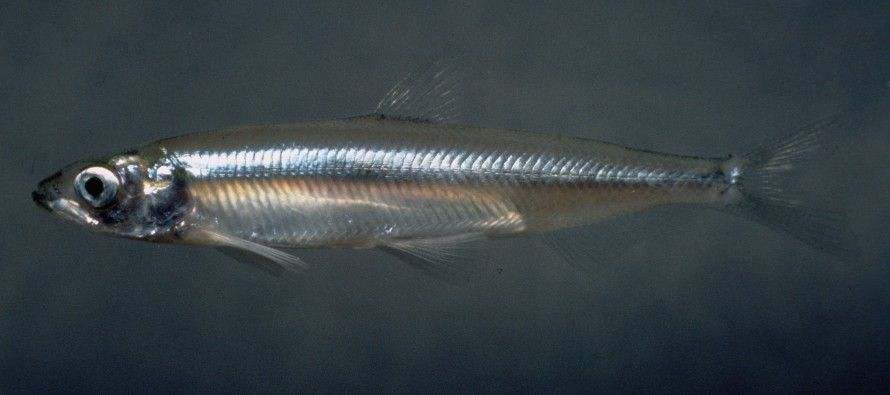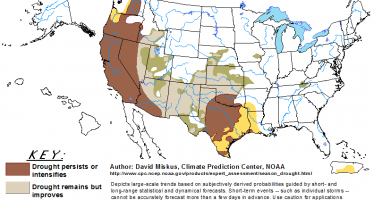NRDC claim of ‘no government-made drought’ doesn’t hold water

Water moves in one direction, memory in another for the National Resources Defense Council. The NRDC seems to be suffering from a case of voluntary amnesia in its running dispute with the Wall Street Journal over whether California is currently suffering from an historic dry spell or a “government-made drought.”
A Journal article, “California’s Fish Fry,” blamed the government for the drought. Peter Lehner, the NRDC’s executive director, replied that it wasn’t the government’s fault. (See excerpts from the his letter below.)If you don’t remember who the NRDC is, they are the environmental organization that brought about the deep reductions in water deliveries in California from 2007 to 2010 due to their lawsuit to protect the Delta Smelt fish from alleged extinction. The federal judge in the case ruled the scientific basis of the lawsuit was bogus and the reductions in water deliveries did not protect the fish from extinction.
Government-created drought
Lehner blames the worst dry spell in California in 119-years for the six-month drought from January through June of this year. But 1894 was not the driest year in the last 119 years in California, as indicated here. California has experienced decades of dry water years without having to reduce water deliveries to farmers.
Lehner is half right that farm water reductions are not universal. But contrary to Lehner, these reductions are targeted at larger corporate-owned farms served by the Central Valley Project.
The Inspector General for the U.S. Department of Interior, in a 2013 audit report titled “Central Valley Project California Repayment and Payoff,” found that farmers’ repayments to pay off the $1.3 billion in bonds for the CVP are lagging behind schedule because of water reductions to large farms.
According to the IG, over the three-year period from 2008 to 2010, actual water deliveries to large CVP farm water contractors were only 41 percent of their allocation, causing a $45 million shortfall in CVP bond repayments. The IG estimated that, by 2030, one large farm operator would have to double its bond payments because of less water being supplied.
An April 9, 2013 Board Letter of the Tuolumne Utilities District explains why the New Melones Dam that releases water for California Central Valley farms sits half empty except in very wet years. It blames not drought, but Congress’ enactment of the Endangered Species Act of 1972 and other legislation.
Smelt a gauge of how much government and economy we have
Moreover, the Delta estuary isn’t the only habitat for the smelt, as Lehner infers. It was revealed in the NRDC’s court case that schools of smelt fish are found throughout the Sacramento Delta.
The NRDC previously alleged that the smelt were found only in the brackish water zone in the San Francisco Bay, where fresh water and salt water mix. In wet years, the boundary line of this pool of brackish water, called the X-2 Zone, is pushed westerly in the San Francisco Bay by fresh water flooding the Delta. In dry years, the brackish water zone line is pushed easterly by saltwater intrusion from the ocean.
But the brackish water zone is also determined by how much water is pumped out of the Delta for water imports to farmers and cities. The X-2 line is set each year by government in order to balance the need to protect fish and provide water to agriculture and urban areas.
In other words, the smelt is used as a gauge of how much government and how much of a water economy California has each year. If the X-2 Zone boundary line is pushed westerly, California has a lot of fish but diminished farming. If the X-2 line is pushed easterly, supposedly we have fewer fish but more agricultural production.
In reality, the Delta Smelt are found throughout the Delta and not just in the X-2 Zone, as the NRDC has contended.
Water war
The water war over where the X-2 line is set means a struggle for 300,000 to 760,000 acre-feet of Delta water, depending on whether it is a dry or wet year. That is enough water minimally to supply the City of San Diego, or at maximum the City of Los Angeles, for one year. The smelt represent a water gauge of how much government and how much economy we have.
If we dedicate enough Delta Bay water to supply the entire City of Los Angeles for one year to protect a few Delta smelt that also exist outside the X-2 zone, then urban water rates will have to rise to offset fixed costs. And farmers, cities and even urban wildlife will suffer. But the entire food chain of jobs that feeds off natural resources bureaucracies will thrive.
All “droughts” in California are man-made. We no longer live in a natural environment controlled by the changes in the “climate.” We live in an urban world dependent on huge water hydraulic systems.
California only has a thin six-month supply of water storage, due to the lack of building new reservoirs in the past 40 years, in part due to opposition by the NRDC. The problem is rainfall capture and storage, not normal natural drought conditions. The NRDC claim that there is no “government created drought” doesn’t hold water.
————————-
Letter to the Wall Street Journal by Peter Lehner:
Your editorial “California’s Fish Fry” (July 15) falsely scapegoats California’s environmental protections without mentioning the real cause. The state’s record dry conditions. January to June 2013 has been the driest period in the last 119 years in California, according to the National Climatic Data Center. Unless President Obama and Gov. Jerry Brown control the weather, this is decidedly not a “government-made drought.”
While corporate agribusiness in the Westlands Water District is receiving reduced water supplies due to drought, these cutbacks aren’t universal. Other Central Valley farms are receiving full water allotments this year. And Southern California’s investments in improved water efficiency mean many large cities are well prepared for a dry year.
Delta smelt is nothing more than a red herring in your editorial. Protections for these endangered native fish actually serve to safeguard thousands of fishing and farming jobs and drinking water in California by maintaining water quality in the estuary. Your proposal to eliminate scientifically sound water conservation measures in the Bay Area/Sacramento-San Joaquin Delta is a false choice between the environment and jobs.
Peter Lehner
Executive Director
Natural Resources Defense Council
Related Articles
Bill threatens religious freedom, critics say
Robert Lauten didn’t come waving a neon sign, but his grievances with Senate Bill 1146 were highlighted in bright yellow.
Water bond drowns in Legislature
A $10.5 billion water bond apparently drowned in the California Senate this past week for the third time since 2010, even
CA Senate jumps into UC tuition fracas
Maybe kids and their parents won’t have to pay higher University of California tuition. Last month, Gov. Jerry Brown tried





